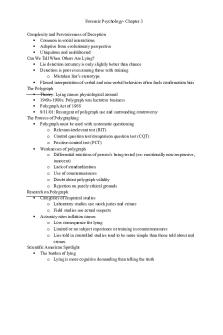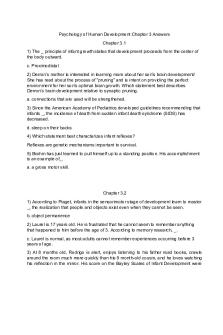Chapter 3 Psychology PDF

| Title | Chapter 3 Psychology |
|---|---|
| Author | Abi Leishman |
| Course | Introductory Psychology |
| Institution | Lakehead University |
| Pages | 8 |
| File Size | 216.7 KB |
| File Type | |
| Total Views | 175 |
Summary
Prof Dr. M. Moland
Chapter 3 - Biological Psychology...
Description
Biological Psychology Chapter 3/ Psych ! Neurons Specialized cells that carry messages throughout the Central Nervous System. ! **Axons speak, Dendrites listen**! • Cell Body !
- Cells life support / executive ! • Dendrites!
- Receive information and conduct it toward the cell body! • Axon!
- Pass the message along to other neutrons or to muscles/glands. ! • Myelin Sheath !
- A layer of fatty tissue that insulates the axons of the neutrons and speeds their messages !
- Myelinated: faster message travel - Un-myelinated: slower message travel/slower neural impulses.
1
Neuron fires an impulse when it receives chemical signals or messages from sense receptors. ! This impulse is an Action Potential !
- Brief electrical charge that travels down the axon.(travels faster if myelinated).!
- All or nothing, based on the stimulation of earlier nerve cells.!
Firing of a Neuron • Generate electricity via chemical events. ! • This process involves the exchange of electrically charged particles—> ions. ! •Interior of a resting axon has an excess of negatively charged ions. While the exterior is more positive —> RESTING POTENTIAL (-70mV)! +++++ ——— +++++
Synapse Axon Terminal:!
- Tip of the axon! Synaptic Vesicles: !
- Contain the neurotransmitters ! Synaptic Cleft: !
- Junction between the axon of one neuron and the dendrite of another. ! 2
Neurotransmitters:
- Chemical messengers ! ** Neurotransmitters bind to the receptor sites on the receiving neuron. Precise, like a key for a lock.**! Acetylcholine[ACE a test]! • Learning and memory ! • Muscle movement! • Disorders: Alzheimer’s disease! Dopamine[DOPe slang for a drug. That was dope man-a druggy]! • Learning and Attention and Movement! • Reinforcement ! • More dopamine=more euphoric=more movement! • Disorders: Schizophrenia ! Norepinephrine[sNORE]! • Sleep and arousal ! • Affects eating habits ! • Wakefullness ! • Predominant in fear! Serotonin[Sorrow tone]! • Regulating mood, sleep, impulsivity and aggression ! • Low serotonin=sad/depression ! • High serotonin=improved mood! GABA-Gamma aminobutyric acid[GAB on and one due to alcoholic slur]! • Increased alcohol= increases GABA activity ! • Learning ! • Controls anxiety ! Endorphin[Endogenous Morphine]! • Relieves pain ! • Produce feelings of pleasure and well-being ! 3
Biological Treatments Antipsychotic Drugs: !
- Block dopamine receptors, lowering levels of dopamine. ! - Such as Schizophrenia in which receptors are hyper sensitive to dopamine. High dopamine levels. ! Antidepressant Drugs: !
- Increase serotonin. By blocking re-uptake of serotonin, serotonin “hangs” around longer in the synaptic cleft increasing serotonin levels. !
Agonists: MIMIC • Similar enough to transmitter to imitate it and its effects. ! • Generally enhance.! Antagonists: BLOCK • Inhibits transmitter release. ! • “antagonize” ! • Naloxone: also an antagonist • Blocks opiate pain relief, and opiate high!
Cerebral hemispheres Cerebrum: Composed of two cerebra hemispheres(left and right)! LEFT
RIGHT
Fine tuned language skills - Comprehension - Reading - Writing - Speaking Logical/scholarly/analytical
Course language skills - Simple writing - Tone of voice - Recognition of faces Creative/artistic/emotional
4
Corpus Callosum:
- Physical connection between the right and left hemispheres. ! Cerebral Cortex:
- Covers the cerebral hemispheres; primary responsible for higher mental processes! - Language! - Memory! - Thinking! Glial cells:
- Cells in the nervous system that support, nourish and support neutrons.! - Produce myelin ! - May also play a rollin thinking and learning ! Brain: The clinical method involves studying the behavioural result of brain injury[posthumous examination] of brain structures to identify damaged areas thought responsible for behavioural conditions existing before death. ! Broca’s area;!
- The speech centre in the 3rd frontal convolution of the left hemisphere of the cerebral cortex. ! Frontal lobe:!
- Mediates movement, problem solving, decision making, inhibition, language, planning ! Parietal lobe:!
- Mediates sense of touch, spatial ability, attention ! Occipital lobe: !
- Vision, edge detection, shape and forms ! Temporal lobe:!
- Memory, hearing, language, complex vision (recognition of faces)! Brain mapping: EEG[Electroencephalogram]! 5
- Measures electrical activity generated by the brain. Can detect rapid changes. Not very specific! TMS[transcranial magnetic stimulation]!
- Applies a strong and quick changing magnetic fields to the skull to enhance or disrupt brain function in a specific region. ! MRI[magnetic resonance imaging]!
- Measures the release of energy from water in biological tissues following exposure to a magnetic field! f-MRI[functional MRI]!
- MRI with measure of blood-oxygen changes! PET[position emission tomography] !
- Measures changes In the brain activity in response to stimuli based on glucose levels usage. !
Brain Stem Medulla:! • Where the spinal cord enters the skull and swells slightly! • Controls automatic functions!
- Heartbeat! - Breathing! - Blood pressure! - coughing/vomiting! - Swallowing! Pons:! • Just above the medulla! • Plays a role in facial movement an touch sensations of the face and sleep and dreaming ! Locus Coeruleus is an area within the pons which is involved In keeping is paralyzed during REM sleep. ! Reticular formation: ! • A collection of neurones ranging from the spinal cord up to the thalamus. ! 6
• Regulates attention, aousal, and alertness! • Filters incoming stimuli !
Limbic System: Amygdala:! • Involved in fear and aggression ! • Processing emotional memories! • Conditioned responses! Removal: mellow Stimuli: rage/fear! Hippocampus:! • Processes memory! • Damage results in prevention of new memories of facts and episodes. ! • Live in the forever present! Thalamus:! • Relay station! • Brains sensory switchboard located on top of the brainstem$ Hypothalamus:! • Lies UNDER the thalamus ! • Regulates !
- Hunger! - Thirst! - Sexual arousal! - Body temperature! Cerebellum: ! • Attached to the rear of the brainstem! • Functions include! 7
- Processing sensory input! - Balance! - Learning motor skills! - Discriminating sounds/music! - Spatial reining, linguistic abilities! - Integrating input from various sensory systems! - Memory-implicit or procedural memory(stick shifts)!
8...
Similar Free PDFs

Forensic Psychology Chapter 3
- 3 Pages

Psychology Chapter 3 Notes
- 4 Pages

Chapter 3 Psychology
- 8 Pages

Psychology Notes- chapter 3
- 3 Pages

Abnormal Psychology Chapter 3
- 9 Pages
Popular Institutions
- Tinajero National High School - Annex
- Politeknik Caltex Riau
- Yokohama City University
- SGT University
- University of Al-Qadisiyah
- Divine Word College of Vigan
- Techniek College Rotterdam
- Universidade de Santiago
- Universiti Teknologi MARA Cawangan Johor Kampus Pasir Gudang
- Poltekkes Kemenkes Yogyakarta
- Baguio City National High School
- Colegio san marcos
- preparatoria uno
- Centro de Bachillerato Tecnológico Industrial y de Servicios No. 107
- Dalian Maritime University
- Quang Trung Secondary School
- Colegio Tecnológico en Informática
- Corporación Regional de Educación Superior
- Grupo CEDVA
- Dar Al Uloom University
- Centro de Estudios Preuniversitarios de la Universidad Nacional de Ingeniería
- 上智大学
- Aakash International School, Nuna Majara
- San Felipe Neri Catholic School
- Kang Chiao International School - New Taipei City
- Misamis Occidental National High School
- Institución Educativa Escuela Normal Juan Ladrilleros
- Kolehiyo ng Pantukan
- Batanes State College
- Instituto Continental
- Sekolah Menengah Kejuruan Kesehatan Kaltara (Tarakan)
- Colegio de La Inmaculada Concepcion - Cebu










